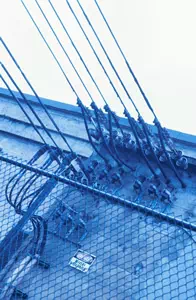 |
||
|
||
This page provides information on equipment and materials for which veterinary facilities may be required to obtain air quality permits:
See the VetCA Clean Air Act page for additional information on the federal law that authorizes the EPA to impose air quality permit requirements. At veterinary facilities, air emissions can come from numerous sources, including:
Permits that may be Required under the Clean Air Act Title I: Some large pieces of equipment may be subject to New Source Performance Standards (NSPSs) under the Clean Air Act. Information on NSPS requirements for certain specific pieces of equipment can be found on VetCA pages dealing with incinerators. Many types of emission involving Hazardous Air Pollutants (HAPs) are also regulated under Title I. Specific cases are discussed in more detail in the next section. Title V: This section of the CAA requires that all "major sources" (and certain minor sources) obtain an overall operating permit. A veterinary facility that qualifies as a major source would be required to have a Title V permit, and may be required to submit a permit application that includes information about emissions, control devices, and the general process at the facility. Permits may limit pollutant emissions and impose monitoring, recordkeeping, and reporting requirements. Monitoring requirements for many facilities with Title V permits are specified in the Compliance Assurance Monitoring (CAM) regulations. For facilities that meet emissions requirements on their permits by using pollution control equipment, CAM may require that the facilities monitor the control equipment to assure that it is operated and maintained as prescribed in their permits. Medical Waste Incinerators40 CFR Part 60:
Under the CAA, EPA regulates air emissions from hospital medical/infectious waste incinerators (HMIWI). When burned, medical waste may emit air pollutants, including:
EPA has developed emission standards that apply both to incinerators used by hospitals and veterinary facilities as well as to those used by commercial waste treatment and disposal companies to treat medical waste. The emission guidelines are intended to meet the requirements of the federal CAA. States can establish their own standards, but they must be at least as protectiveas the federal standards. These standards will result in reductions in the air emissions of concern from HMIWI. Generators (Stationary Reciprocating Internal Combustion Engines)Stationary reciprocating internal combustion engines (usually gas or diesel generators) at veterinary facilities are probably subject to this standard if they:
AsbestosA veterinary facility that performs demolition and renovation operations will be subject to the CAA NESHAP for asbestos. Here is a brief summary of requirements; please refer to the additional resources listed below for more details:
Additional resources for asbestos:
Ethylene oxide (EtO)Some healthcare facilities use ethylene oxide as a sterilant for certain types of healthcare supplies and devices. In some cases, manufacturers recommend this practice to ensure the sterility of a product. On December 28, 2007 the Environmental Protection Agency published the Final National Emissions Standards for Ethylene Oxide Sterilizers, used by some healthcare facilities to sterilize medical devices. The standards generally require hospital ethylene oxide sterilization facilities to sterilize full loads of items to reduce hazardous emissions. Exceptions include when central services staff, a hospital administrator or physician on duty determine that a less than full load is medically necessary, or the sterilizer has an acceptable air pollution control device. RefrigerantsThe purpose of Section 608 of the CAA is to maximize the recovery and recycling of refrigerants during the servicing and disposal of stationary air conditioning and refrigeration equipment. Requirements covered under this section include:
EPA Region 6 provides an information page with links to documentation of recent rules related to leak repair requirements and refrigerant venting, and to technical information. |
||
 Air
Permitting
Air
Permitting